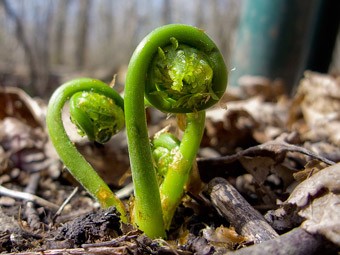 Fiddleheads are a New Brunswick delicacy.
Fiddleheads are a New Brunswick delicacy.- New Brunswick is the largest of Canada’s three Maritime Provinces. New Brunswick is 73,440 sq. km (28,354 sq. mi.).
- There are three distinct coastlines in New Brunswick that together span 2,250 km (1,398 mi.).
- The province has eight cities: Fredericton (Capital), Saint John, Moncton, Dieppe, Edmundston, Campbellton, Bathurst and Miramichi.
- Statistics Canada estimates the provincial population in 2016 to have been 747,101.
- New Brunswick is Canada’s only officially bilingual province. English and French have been the province’s official languages since 1969.
- New Brunswick’s Bay of Fundy has the highest tides on earth and is one of the most accessible viewing areas for marine life in the world.
- The St. John River system is the second largest on North America’s Atlantic coastline and extends from the northwest point of the province to the southern coast, where it empties into the Bay of Fundy at Saint John.
- Fiddleheads (edible, tightly coiled ferns that resemble the spiral end of a violin or fiddle) are a New Brunswick delicacy. Freshly picked from the riverbanks in the spring, they are wonderful served with Atlantic salmon!
- New Brunswick has many species of birds. Grand Manan Island in the Fundy Isles is one of the top birding spots in North America. Grand Manan Island is also the Dulse Capital of the World. Dulse is an edible dried seaweed with many healthy properties, containing many minerals and a variety of vitamins.
- New Brunswick has more than 60 lighthouses and is famous for its inland lighthouse system that dots its inland rivers.
- The Bay of Fundy is a pristine sanctuary for all kinds of rare, unusual wild creatures. Immense blooms of plankton provide a vast feeding ground for up to 15 species of toothed and baleen whales, including Finbacks, Humpbacks, Pilot whales and the rare right whale.
- New Brunswick has more than 55 remaining covered bridges and Kings County is considered the Covered Bridge Capital of Atlantic Canada. The bridges that are standing today are living examples of the pride of craftsmanship, heritage, engineering and design of our forefathers. The "Longest Covered Bridge in the World" is located in Hartland, New Brunswick, at 390 m. (1,282 ft.) long.
- New Brunswick has the warmest saltwater beaches in Canada.
- New Brunswick is accessible by major airports and highways, as well as by cruise ship, ferry and by rail.
- The Appalachian Range is one of the oldest mountain ranges on earth.
- Ganong Brothers Ltd., established in 1873 in St. Stephen, created the first chocolate and nut candy bar by individually wrapping pieces of chocolate and selling them for a nickel.
- Manufacturing, mining and forestry are the main industries, and the province is considered a North American leader in forest management.
New Brunswick Inventions
- Scuba tank, James Elliot and Alexander McAvity, Saint John, 1839.
- Compound steam engine, Benjamin F. Tibbets, Fredericton, 1845.
- Snow blower, Robert Carr Harris, Dalhousie, 1870.
- Sardine Cans, Henry T. Austin, Blacks Harbour, 1932.
- Clothes washer with roller wringer, John E. Turnbull, Saint John, 1843.
- Combined hot and cold water faucets, Thomas Campbell, Saint John, 1880.
- Crossword game, Edward R. MacDonald, Shediac, 1926.
- Dump-box for Trucks, Robert T. Mawhinney, Saint John, 1920.
- Ganong Brothers Ltd. are the first in Canada to produce lollipops (1895), to use cellophane packaging (1920), to make peppermint rolls (1926), and to sell Valentine candy in heart-shaped boxes (1932).
More ‘Neat’ Information About New Brunswick
- The world’s oldest intact shark fossil, over 409-million years old, was discovered near Atholville in the heart of the Appalachian Range.
- The highest peak in the Maritimes is located at Mount Carleton Provincial Park. It measures in at 820 m. (2,690 ft.).
- New Brunswick’s Sir Charles G.D. Roberts was the first Canadian poet to be knighted.
- The first French settlement in North America was attempted in 1604 on Saint Croix Island, near Saint Andrews.
- New Brunswick is home to the largest ocean tidal whirlpool in the western hemispheres. It is located off the coast of Deer Island and is named the ‘Old Sow’.
- The University of New Brunswick is tied with the University of Georgia as being the oldest University in North America.
- The oldest “still in use” university building in Canada is the Old Arts Building, located on the Fredericton Campus of the University of New Brunswick.
- The New Brunswick Museum in Saint John is Canada’s first museum, established in 1842.
- Fredericton’s Willie O’Ree was the first black player in the NHL.
- Shediac is home to the World’s Largest Lobster. This statue is 10.5 m (34 ft.) long and is 4.5 m (15 ft.) high. This monster weighs 90 tonnes!
- Sabian Cymbals, Meductic, is one of the first cymbal-manufacturing companies in North America.
- McCain Foods Limited, established in Florenceville in 1957, is one of the largest manufacturer of frozen French fries and potato specialties.
- Irving Oil Limited was established in Bouctouche in 1924. In 1977, it became the first Canadian oil company to offer unleaded gasoline at its retail outlets. In the late 1990s it became the first oil company in Canada and one of the first in North America to offer gasoline with very low sulphur content. Irving has also been instrumental in partnering with the New England Aquarium in the protection of the rare Atlantic right whale by changing its shipping lanes to avoid collisions in the Bay of Fundy.
